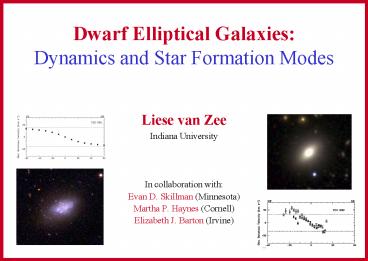Dwarf Elliptical Galaxies: Dynamics and Star Formation Modes - PowerPoint PPT Presentation
1 / 30
Title:
Dwarf Elliptical Galaxies: Dynamics and Star Formation Modes
Description:
Extremely low mass galaxies may lose most or all of their ISM after a vigorous ... Anisotropy Parameter. MB. Log (v/s)* van Zee et al. 2004 ... – PowerPoint PPT presentation
Number of Views:60
Avg rating:3.0/5.0
Title: Dwarf Elliptical Galaxies: Dynamics and Star Formation Modes
1
Dwarf Elliptical Galaxies Dynamics and Star
Formation Modes
- Liese van Zee
- Indiana University
- In collaboration with
- Evan D. Skillman (Minnesota)
- Martha P. Haynes (Cornell)
- Elizabeth J. Barton (Irvine)
2
Dwarf Galaxy Evolutionary Scenarios
3
Blow-out and Blow-away
Extremely low mass galaxies may lose most or all
of their ISM after a vigorous star formation
episode.
Ferrara Tolstoy (2000)
4
Morphological Similarities
Binggeli 1994
5
Dynamical Similarities?
- The way it was (pre-2000)
- Dwarf ellipticals have high velocity dispersion
- Dwarf ellipticals have no (little) rotation
- Dwarf irregulars have significant rotation
- The way it is (post-2000)
- Some dwarf ellipticals have significant rotation
- Pedraz et al., Geha et al., van Zee et al., de
Rijcke et al., Miller et al. - Most dwarf irregulars have significant rotation
- Some dwarf irregulars are tumbling systems
- e.g., NGC 625, Côté et al.
6
dE Kinematics - Rotation Curves
NGC 185
NGC 147
NGC 205
Bender et al. 1991
7
Gas-Rich Dwarf GalaxiesRotation Curves and
Angular Momentum
- All moderate luminosity gas-rich dwarf galaxies
are rotation dominated. - BCDs have more steeply rising rotation curves
than LSB dwarf galaxies. - This translates into lower specific angular
momenta for most HSB dwarf galaxies.
van Zee et al. 2001
8
New Observations of LG dEs
Geha et al 2006
Simien Prugniel 2002
9
Testing Dynamical ConstraintsSample Selection
- 16 dEs from the Virgo Cluster Catalog (Binggeli
et al. 1985) - 15.2 gt MB gt 17.4 ( mB lt 16. )
- V lt 3000 km/s
- Selected to maximize detection of possible
rotation ? gt 0.25
10
Distribution of Virgo dE Sample
The sample includes dEs in a range of
environments, including cluster core and
outskirts. Observations Long slit
observations with the Double Spectrograph on the
Palomar 5m of 16 dEs. Optical imaging with the
VATT 1.8m and WIYN 3.5m
van Zee, Skillman, Haynes 2004
11
Integrated Spectra
Rotation Curves
Rotation Velocity
van Zee, Skillman, Haynes 2004
Spatial Offset
12
Anisotropy Parameter
Approximately half of the Virgo dE sample show
significant rotational support.
van Zee et al. 2004
13
Environmental Effects in Virgo
Hot ICM can strip ISM of infalling galaxies.
14
HI Deficiency in Virgo
Spiral galaxies in the Virgo cluster are often HI
deficient.
Peak DEF gt 1.2 Light DEF lt 0.1
Solanes et al. 2001
15
Non-rotating dEs favor the cluster core Rotating
dEs favor the outskirts.
van Zee, Skillman, Haynes 2004
16
Structural Parameters of dIs and dEs
dIs and dEs have similar structural parameters in
the optical.
van Zee, Barton, Skillman 2004
17
Luminosity-Line Width Relation
Suggests that the stellar kinematics of some
Virgo dEs may be similar to those of dIs.
At most, rotating dEs may have faded by 1-2
magnitudes from their parent gas-rich population.
van Zee, Barton Skillman 2004
18
Color-color Diagrams for dEs
Rotating and non-rotating dEs have similar
optical colors. Dominant stellar populations are
approximately 5-7 Gyr old.
van Zee, Barton, Skillman 2004
19
Dwarf Galaxy Evolutionary Scenarios
20
Chemical Enrichment in dEs
The a/Fe ratio is sub-solar or solar in both
rotating and non-rotating dEs. This suggests a
more gradual chemical enrichment history than
found in giant elliptical galaxies.
Giant Ellipticals
van Zee, Barton, Skillman 2004
21
Dwarf Galaxy Evolutionary Scenarios
Possible, but not a necessary transition for a
normal dI
Possible, with assistance from environment.
Possible, with assistance from environment.
22
Conclusions
- A significant fraction of dEs are rotation
dominated, with typical rotation velocities
similar to those of dIs. - A multitude of evolutionary scenarios are
possible for cluster dwarf elliptical galaxies. - Formation in situ
- Formation in group environments which later
infall into cluster - Ram pressure stripping of infalling dIs
23
Open Issues and Questions
- Where are the recently stripped dIs?
- Are any dEs formed in isolation?
- Is a burst really necessary?
- What about the different specific frequency of
GCs? - Fading ? dEs should be lower surface brightness
24
The SMUDGES Survey
L. van Zee D. Schade M. Iyer
(Systematic Multiwavelength Unbiased catalog of
Dwarf Galaxies and Evolution of Structure )
- Key goals
- Determine the fraction of dwarf galaxies that go
through a starburst phase. - Investigate trigger mechanisms for the
starburst, and measure the duty cycle. - Calculate the luminosity function for faint
galaxies and compare with predictions for number
counts from cosmological models. - Investigate if there are intrinsic differences
between starbursting and quiescent dwarf galaxies.
- Observations
- Imaging of 134 square degrees in B,V, and I
with the WIYN 0.9m - COMPLETED January 2006!
- Optical spectroscopy of 13,000 galaxies with
the WIYN 3.5m - On-going 2004-2007(?)
- Imaging in Ha of thousands of galaxies with the
WIYN 0.9m - First observations November 2005
25
SMUDGES one degree fields
Field 12360700
MOSAIC Camera on WIYN 0.9m V-band
- Final survey data products will include
- Co-added images in all filters
- Source catalogs
- Redshifts
- Star formation rates
- UBVR colors
26
SMUDGES UBVR Ha imaging
27
(No Transcript)
28
Rotation Velocity
Spatial Offset
van Zee, Skillman, Haynes 2004
29
Rotation Velocity
Spatial Offset
van Zee, Skillman, Haynes 2004
30
Integrated Spectra
van Zee, Skillman, Haynes 2004































